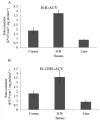Novel biotinylated lipid prodrugs of acyclovir for the treatment of herpetic keratitis (HK): transporter recognition, tissue stability and antiviral activity
- PMID: 23657675
- PMCID: PMC3746831
- DOI: 10.1007/s11095-013-1059-7
Novel biotinylated lipid prodrugs of acyclovir for the treatment of herpetic keratitis (HK): transporter recognition, tissue stability and antiviral activity
Abstract
Purpose: Biotinylated lipid prodrugs of acyclovir (ACV) were designed to target the sodium dependent multivitamin transporter (SMVT) on the cornea to facilitate enhanced cellular absorption of ACV.
Methods: All the prodrugs were screened for in vitro cellular uptake, interaction with SMVT, docking analysis, cytotoxicity, enzymatic stability and antiviral activity.
Results: Uptake of biotinylated lipid prodrugs of ACV (B-R-ACV and B-12HS-ACV) was significantly higher than biotinylated prodrug (B-ACV), lipid prodrugs (R-ACV and 12HS-ACV) and ACV in corneal cells. Transepithelial transport across rabbit corneas indicated the recognition of the prodrugs by SMVT. Average Vina scores obtained from docking studies further confirmed that biotinylated lipid prodrugs possess enhanced affinity towards SMVT. All the prodrugs studied did not cause any cytotoxicity and were found to be safe and non-toxic. B-R-ACV and B-12HS-ACV were found to be relatively more stable in ocular tissue homogenates and exhibited excellent antiviral activity.
Conclusions: Biotinylated lipid prodrugs demonstrated synergistic improvement in cellular uptake due to recognition of the prodrugs by SMVT on the cornea and lipid mediated transcellular diffusion. These biotinylated lipid prodrugs appear to be promising drug candidates for the treatment of herpetic keratitis (HK) and may lower ACV resistance in patients with poor clinical response.
Figures







Similar articles
-
Targeted lipid based drug conjugates: a novel strategy for drug delivery.Int J Pharm. 2012 Sep 15;434(1-2):315-24. doi: 10.1016/j.ijpharm.2012.05.033. Epub 2012 Jun 9. Int J Pharm. 2012. PMID: 22692074 Free PMC article.
-
Novel dipeptide prodrugs of acyclovir for ocular herpes infections: Bioreversion, antiviral activity and transport across rabbit cornea.Curr Eye Res. 2003 Mar-Apr;26(3-4):151-63. doi: 10.1076/ceyr.26.3.151.14893. Curr Eye Res. 2003. PMID: 12815543
-
Transport of acyclovir ester prodrugs through rabbit cornea and SIRC-rabbit corneal epithelial cell line.J Pharm Sci. 2001 Oct;90(10):1505-15. doi: 10.1002/jps.1101. J Pharm Sci. 2001. PMID: 11745709
-
[Herpes simplex virus latency, reactivation, and a new antiviral therapy for herpetic keratitis].Nippon Ganka Gakkai Zasshi. 2008 Mar;112(3):247-64; discussion 265. Nippon Ganka Gakkai Zasshi. 2008. PMID: 18411713 Review. Japanese.
-
Antiviral prodrugs - the development of successful prodrug strategies for antiviral chemotherapy.Br J Pharmacol. 2006 Jan;147(1):1-11. doi: 10.1038/sj.bjp.0706446. Br J Pharmacol. 2006. PMID: 16284630 Free PMC article. Review.
Cited by
-
Ocular prodrugs: Attributes and challenges.Asian J Pharm Sci. 2021 Mar;16(2):175-191. doi: 10.1016/j.ajps.2020.08.002. Epub 2020 Sep 28. Asian J Pharm Sci. 2021. PMID: 33995612 Free PMC article. Review.
-
A comprehensive insight on ocular pharmacokinetics.Drug Deliv Transl Res. 2016 Dec;6(6):735-754. doi: 10.1007/s13346-016-0339-2. Drug Deliv Transl Res. 2016. PMID: 27798766 Free PMC article. Review.
-
Herpes Simplex Virus 1 (HSV-1) 0ΔNLS Live-Attenuated Vaccine Protects against Ocular HSV-1 Infection in the Absence of Neutralizing Antibody in HSV-1 gB T Cell Receptor-Specific Transgenic Mice.J Virol. 2020 Nov 23;94(24):e01000-20. doi: 10.1128/JVI.01000-20. Print 2020 Nov 23. J Virol. 2020. PMID: 32999018 Free PMC article.
-
Herpes simplex keratitis-induced endophthalmitis in a patient with AIDS with disseminated tuberculosis.BMJ Case Rep. 2014 Feb 27;2014:bcr2013202804. doi: 10.1136/bcr-2013-202804. BMJ Case Rep. 2014. PMID: 24577179 Free PMC article.
-
Prodrug approach to improve absorption of prednisolone.Int J Pharm. 2015 Jun 20;487(1-2):242-9. doi: 10.1016/j.ijpharm.2015.04.029. Epub 2015 Apr 15. Int J Pharm. 2015. PMID: 25888804 Free PMC article.
References
-
- Duan R, de Vries RD, Osterhaus AD, Remeijer L, Verjans GM. Acyclovir-resistant corneal HSV-1 isolates from patients with herpetic keratitis. J Infect Dis. 2008 Sep 1;198(5):659–63. - PubMed
-
- Remeijer L, Osterhaus A, Verjans G. Human herpes simplex virus keratitis: the pathogenesis revisited. Ocul Immunol Inflamm. 2004 Dec;12(4):255–85. - PubMed
-
- Xu F, Sternberg MR, Kottiri BJ, McQuillan GM, Lee FK, Nahmias AJ, et al. Trends in herpes simplex virus type 1 and type 2 seroprevalence in the United States. JAMA. 2006 Aug 23;296(8):964–73. - PubMed
Publication types
MeSH terms
Substances
Grants and funding
LinkOut - more resources
Full Text Sources
Other Literature Sources

